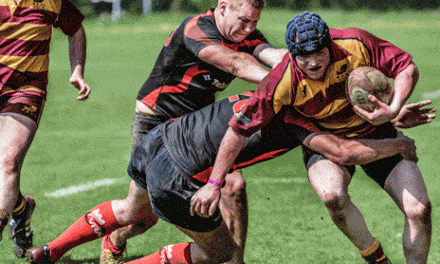
The Haptic Rocker, developed at Rice University, uses a rotating arm to brush a soft rubber pad over the skin of the arm. The more a prosthetic hand closes, the more the pad brushes the skin. (Photo courtesy of Brandon Martin/Rice University)
Via the use of a skin-stretch device on their upper arm, blindfolded study participants were able to double their ability to discern the size of objects grasped with a prosthetic hand, according to researchers.
“Humans have an innate sense of how the parts of their bodies are positioned, even if they can’t see them,” says Marcia O’Malley, professor of mechanical engineering at Rice University. “This ‘muscle sense’ is what allows people to type on a keyboard, hold a cup, throw a ball, use a brake pedal and do countless other daily tasks.
In a study presented recently at the World Haptics 2017 conference, O’Malley and her research team examined the use of a prosthesis in combination with a skin-stretch rocking device for proprioception.
“We’ve been limited to testing haptic feedback with simple grippers or virtual environments that replicate what amputees experience,” O’Malley continues, in a media release from Rice University. “That changed when I was contacted last year by representatives of Antonio Bicchi’s research group at Pisa and IIT who were interested in testing their prosthetic hand with our haptic feedback system.”
At Rice University, Pisan graduate student Edoardo Battaglia and Rice graduate student Janelle Clark tested MAHI’s Rice Haptic Rocker in conjunction with the Pisa/IIT SoftHand. They measured how well blindfolded subjects could distinguish the size of grasped objects both with and without proprioceptive feedback.
Study participants used the SoftHand to grasp objects of varying shapes and sizes, ranging from grapefruit-sized balls to coins (quarters). To close the hand, subjects simply flexed a muscle in their forearm. Electrodes taped to the arm picked up electric signals from the flexing muscle and transmitted those to the motor in the SoftHand.
For the size-discrimination test, subjects were blindfolded and asked to grasp two different objects. They were then asked which of the two was larger. Without haptic feedback, the blindfolded subjects had to base their guesses on intuition. They chose correctly only about 33% of the time. When they performed the same tests with feedback from the Rice Haptic Rocker, the subjects correctly distinguished the larger from smaller objects more than 70% of the time, the release explains.
The research team is following up to see if amputees receive a similar benefit from using the haptic rocker in conjunction with the Soft-Hand, the release continues.
[Source(s): Rice University, Science Daily]




